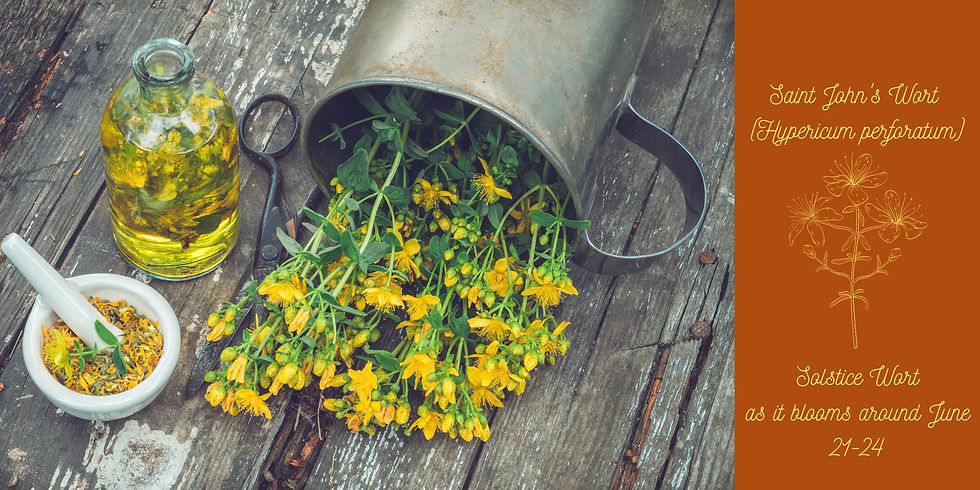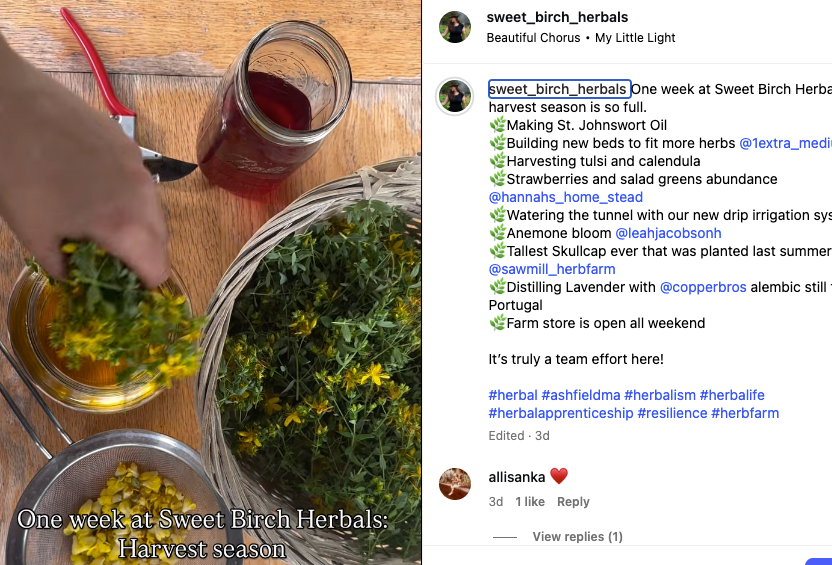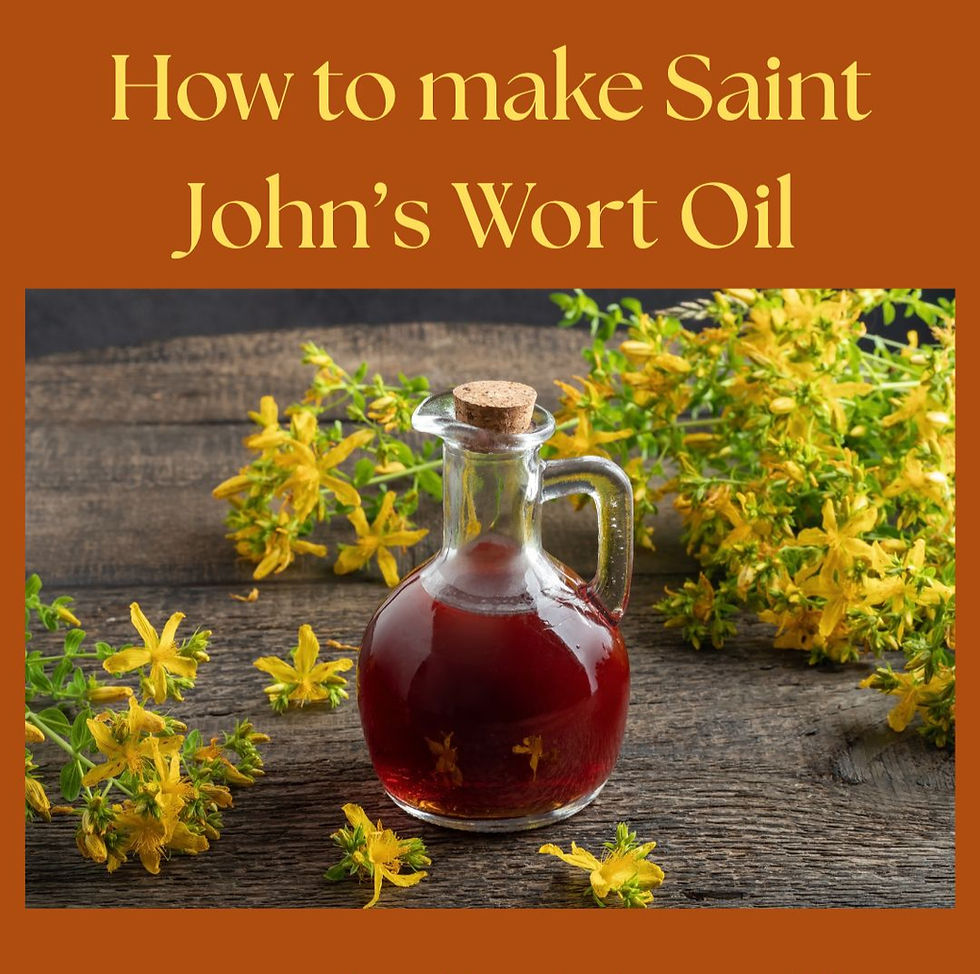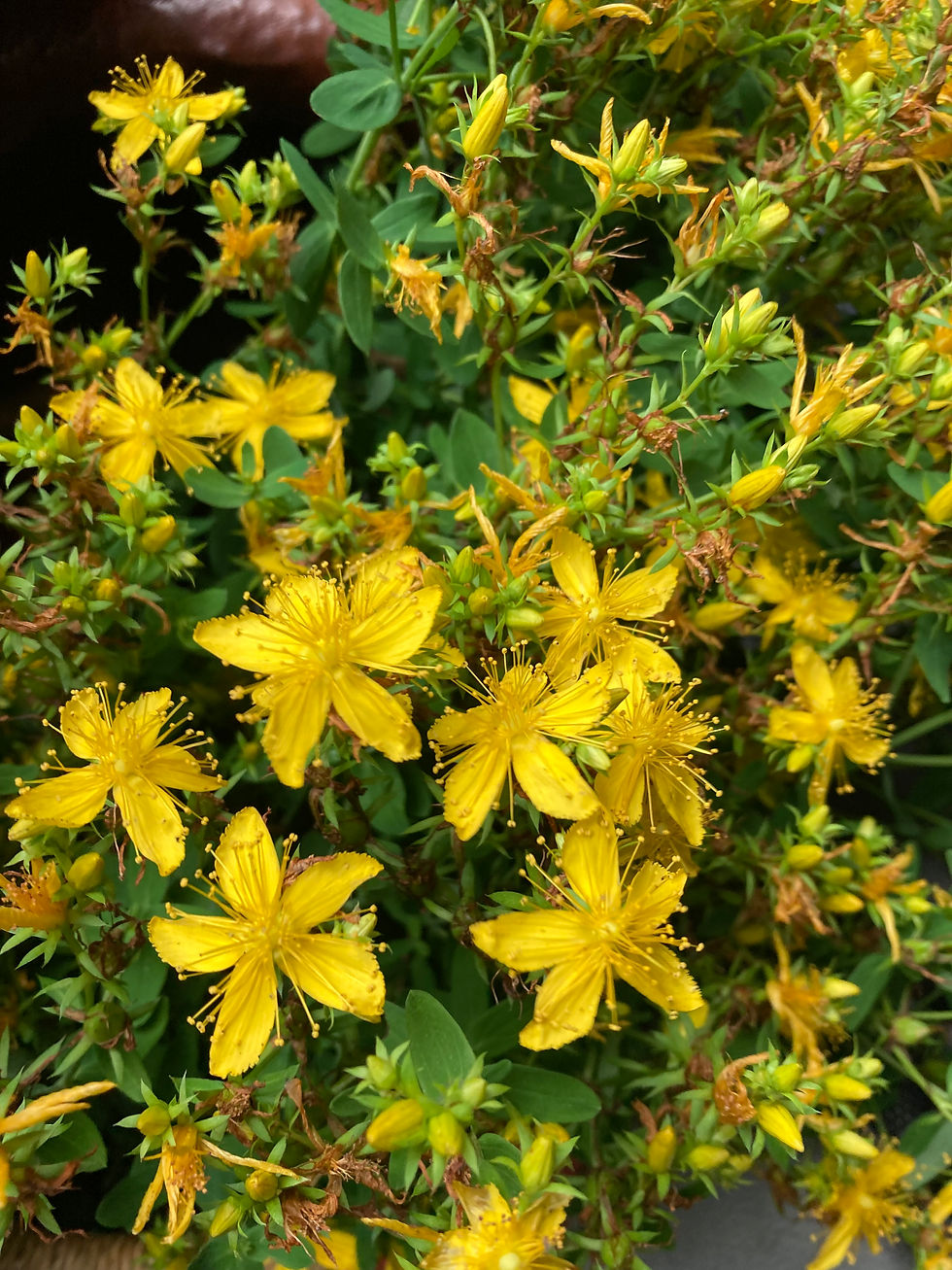Saint John's Wort Oil for Nerve & Spinal Pain
- Hannah Jacobson-Hardy

- Jul 15
- 4 min read

Every Summer Solstice St. John's Wort begins to flower in the wild and our gardens, true sign that summer has begun. This plant has been used for hundreds of years for easing pain, lifting the mood, bringing light into the darkness of our minds, and fighting infections.
One interesting fact is when held up to the sunlight, there are tiny holes in the plant's leaves and flowers. This is what has been recorded in the Doctrine of Signatures, ancient texts that link how plants grow to what they do for the body. It is as if they are showing us how to let the light in.
In this post I will share the way I make a potent oil for topical use which has been known to ease peripheral neuralgia and nerve pain.
Folklore:
"The etymology associated with this herb is actually quite gory. Saint John’s wort refers to the bright red dye released when the plant is crushed up. The herb’s coloration emulates blood, linking it to the gruesome beheading of John the Baptist. Hence, Saint John’s wort.
This herb is commonly picked on June 24th, the feast day of John the Baptist. In folkloric tradition, simply placing a sprig of this wort under your pillow on Saint John’s Eve was thought to bring special blessings and protection from death in the coming year." - The Golden Poppy
Saint John's Wort oil is the only oil I make with fresh leaves and flowers. All others are made from dried or wilted herbs to prevent bacteria growth. It is also the only oil I will put in full sun for several days. All other herbal oils are made out of direct sunlight. Read on for tips on making a potent fresh St. John's Wort oil.
If you'd rather source the oil from me, find it here.
St. John's Wort (Hypericum perforatum)
Family: Clusiaceae (Hypericaceae)
Description: not native to North America. Perennial, 1-3 ft. tall, small leaves, oblong, fitted with translucent glands. Flowers are yellow, 5 petals, black dots on margin, stamens in a bushy cluster.
Location: waste areas, fields, prefers poor soil, grows in patches.
Part Used: flowers, leaf Gathering Time: when flowering, June-July (Solstice) hence the other name is Solstice Wort
Named after St. John
Taste: Bitter, mildly sweet, sour Energy: dry/oily, damp/cool
Organ Affiliates: Nerves, Liver, Solar Plexus
Tissue State: Depression
Key Constituents: Dianthrones (hypericin and pseudohypericin), essential oils, tannins, flavonoids, resins, plant acids, alkaloids, phloroglucinols (hyperforin)
Western Classification: anti anxiety, antibacterial, antidepressant, anti-fungal, anti-inflammatory, antiseptic, antispasmodic, antiviral, astringent, bitter tonic, diuretic, expectorant, hepatic, nervine, sedative, vulnerary.
Chinese Classification: nervous system, female reproductive, liver-gallbladder, mucous membranes, stomach-solar plexus, GI tract, immune system, kidney/bladder, lungs-respiratory, muscular-skeletal, skin, adrenals

Preparation and Dosage
Tea: 1 tsp per 8 oz water, steep covered 45 minutes. 4 oz 3-4 daily
Extract: 1:2 fresh, 1:5 dried @60% ETOH 15-30 drops 3 x daily
Oil: 1:2 fresh flowers and unopened buds. Warm infusion 2-4 weeks in sun
Triune: up to 1/9
Cautions/Contraindications: Caution, some experience photo-dermatitis from exposure to sun or skin where oil has been applied. Caution with SSRIs
Saint John’s wort should be avoided by patients with known allergies or hypersensitivities to the herb.
This herb should not be combined with anti-depressant pharmaceuticals, protease inhibitors or other pharmaceutical drugs, such as oral contraceptives. Saint John’s wort can reduce the bioavailability of these pharmaceuticals decreasing their overall effectiveness.
It also interacts with birth control medications as well as many other medications, so double check with an herbalist, doctor, or pharmacist before taking St. John’s Wort if you take any medications.
It is also not recommended to utilize this herb during pregnancy, while nursing or for children under the age of 2.
Key Symptoms: viral infections, nerve damage, depression-anxiety
Uses:
Muscular- Skeletal: Called arnica for the spine, heals damaged nerves
Nervous System: a) antidepressant, anti-anxiety, SAD seasonal affective disorder. b) Spirit Strengthener, Solar plexus 3rd chakra of will. Lack of decision making, wishy washy, rumination, spinning in circles. Galvanizes the spirit. c) Nerve Injury/Pain/Fragility: restorative and curative. TMJ and shingles, sciatica, neuralgia, peripheral neuropathy, spinal, neck, head injuries, relieves pain and inflammation, numbness. Restores fragile nerves. Not for use from spinal pain due to fever.
Lymph/Immune: antiviral, colds and flus, epstein barr, mono, HPV, Herpes, HIV/AIDS. Antibacterial - staph, candida, e coli
Lungs/Respiratory: relieves spasmodic coughing, coughing up blood
Kidney/Bladder: astringent and diuretic, tones & stops spasms in bladder/sphincter, bedwetting in older children and adults
Digestion/GI: cholagogue, aparient, peristalsis. Tones L.I. and Liver, GB. Quiets irritated GI tracts. May treat jaundice. Take edible oil internally for all “itis” and IBS, weak stomach. We make ours with Jojoba oil so not to be taken internally. Use olive oil for internal infusion.
Skin/Muscular-Skeletal: topical oil for healing burns, cuts, scrapes, bites, nerve pain, varicosities, bruises, strains, sprains, shin splints. Liver wind spasms, ticks, tremors, surgical incisions. Salve/compress to dispel hard tumors, skin ulcerations, cystic breasts
Female Reproductive: nerves and liver to help menstruation. menorrhagia , excessive bleeding, dysmenorrhea, cramps, mood swings/depression

Recipe for Saint John's Wort Oil
fresh picked Saint John's Wort flowers, buds, some leaves (top 4" of plant in flower).
1 quart organic olive oil or jojoba oil
1 tsp. 190 proof alcohol
1 quart mason jar + lid
wax paper
scissors
Harvest fresh Saint John's Wort in the morning after the dew has evaporated. Shake off any bugs. I like to leave mine in a basket outside for an hour to let the bugs fly away.
chop the plant and fill your glass jar to the top, loosely packed
cover the plant in oil of choice and add 1 tsp. of alcohol to kill any possible bacteria as this is a fresh plant oil. The alcohol also assists in pulling medicinal qualities into your oil.
cover and label with date, herb, location, and ready in 2 weeks.
place jar in full sun for 1 week, then dark for 1 week. you should see the oil becomes dark red/brown in color, this is what you want, it is the hypericin! if any mold forms, discard.
strain after 2 weeks but not more than 1 month and keep in a dark place or amber bottle.
apply liberally on aches, pains, neuralgia, spine pain. do not sit in the sun after as it may cause dermatitis
keeps for 1 year in a cool dark place
References:
Materia Medica - Chris Marano







Comments